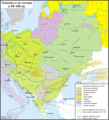فایل:Slav-7-8-obrez.png

سیناق گؤستریشی اؤلچوسو: ۵۴۴ × ۵۹۹ پیکسل. آیری کیفیتلر: ۲۱۸ × ۲۴۰ پیکسل | ۴۳۶ × ۴۸۰ پیکسل | ۶۹۸ × ۷۶۸ پیکسل | ۹۳۰ × ۱٬۰۲۴ پیکسل | ۱٬۸۶۰ × ۲٬۰۴۸ پیکسل | ۳٬۰۵۱ × ۳٬۳۵۹ پیکسل.
فایلین اصلی (۳٬۰۵۱ × ۳٬۳۵۹ پیکسل, فایل اؤلچوسو: ۳۳۹ کیلوبایت, MIME نوعو: image/png)
فايل گئچمیشی
فايلین اولکی وئرسیياسینی گؤرمک اۆچون گۆن/تاریخ بؤلمهسیندهکی تاریخلری تێقلايین.
| تاریخ/واخت | کیچیک عکس | اؤلچولر | ایشلدن | باخیش | |
|---|---|---|---|---|---|
| ایندیکی | ۱۲ آقوست ۲۰۲۳، ساعت ۱۵:۱۳ |  | ۳٬۰۵۱ در ۳٬۳۵۹ (۳۳۹ کیلوبایت) | Gyalu22 | Reverted to version as of 13:16, 23 October 2022 (UTC) Look at the atlas, don't do your own research |
| ۱ ژوئن ۲۰۲۳، ساعت ۱۷:۴۳ |  | ۳٬۰۵۱ در ۳٬۳۵۹ (۳۰۹ کیلوبایت) | Shibbolet3579 | enice was still in the Byzantine Empire at this time. Avars were also present around Vienna and in central Transylvania, evidenced by graves & toponyms. There was a linguistic contact between Albanians and Vlachs, evidenced by the non-Slavic words present in both languages. Placed the Etelköz of the Magyars and the Crimean byzantine Greeks. South-Slavic toponyms (as Trnava for "tip, hillock, mound") evidenced a South-Slavic presence in southern Transylvania. Concerning the Eastern romance spe... | |
| ۲۳ اوْکتوبر ۲۰۲۲، ساعت ۱۳:۱۶ |  | ۳٬۰۵۱ در ۳٬۳۵۹ (۳۳۹ کیلوبایت) | Gyalu22 | Reverted bad faith edit, restored to version as of 26 July 2011. The Westermanns Atlas is an irrelevant source for the previous map, as only the Southern Carpathians are shown as possibly inhabited by the Wallachians. | |
| ۲۸ آوریل ۲۰۱۴، ساعت ۱۵:۰۹ |  | ۳٬۰۵۱ در ۳٬۳۵۹ (۳۰۲ کیلوبایت) | Spiridon Ion Cepleanu | Bulgarian kingdom & east-romance vlachs according with the universitary atlases of history and the Grosser Atlas zur Weltgeschichte, dir. Hans-Erich Stier, Westermann, 1985, ISBN 3-14-10-0919-8, pp. 50, 55-57, 61 & 64. | |
| ۲۶ جولای ۲۰۱۱، ساعت ۱۸:۲۷ |  | ۳٬۰۵۱ در ۳٬۳۵۹ (۳۳۹ کیلوبایت) | Koryakov Yuri | The map's resolution is drastically decreased. Undo | |
| ۲۶ جولای ۲۰۱۱، ساعت ۰۴:۵۳ |  | ۵۴۴ در ۵۹۹ (۳۲۹ کیلوبایت) | Spiridon Ion Cepleanu | On the original version of this map, the eastern romance language-spoken populations ("Vlachs" or "Volokhs") are draw only in a little area around Sredets (today Sofia), according with only one of the POVs, called "Röslerian" (since Eduard Robert Rösler | |
| ۱۰ مارس ۲۰۰۸، ساعت ۱۳:۵۲ |  | ۳٬۰۵۱ در ۳٬۳۵۹ (۳۳۹ کیلوبایت) | Koryakov Yuri | {{Information |Description= |Source= self-made |Date=March 2008 |Author= Koryakov Yuri |other_versions= }} == Licensing == {{self|cc-by-sa-3.0}} Category:Maps of the history of Russia in Russian [[Category:Maps |
فايل ایشلدمهسی
آشاغیداکی 2 صحیفهلر بو فایلا باغلانیرلار
فایلین باشاباش ایشلنیلمهسی
بو فایل آشاغی داکی آیری ویکی لرده ایشلَنیر:
- ar.wikipedia.org-ده ایشلنمهسی
- arz.wikipedia.org-ده ایشلنمهسی
- ba.wikipedia.org-ده ایشلنمهسی
- be-tarask.wikipedia.org-ده ایشلنمهسی
- be.wikipedia.org-ده ایشلنمهسی
- bg.wikipedia.org-ده ایشلنمهسی
- ce.wikipedia.org-ده ایشلنمهسی
- cs.wikipedia.org-ده ایشلنمهسی
- cv.wikipedia.org-ده ایشلنمهسی
- da.wikipedia.org-ده ایشلنمهسی
- de.wikipedia.org-ده ایشلنمهسی
- en.wikipedia.org-ده ایشلنمهسی
بو فایلینسراسری ایستفاده لرینه باخین.

